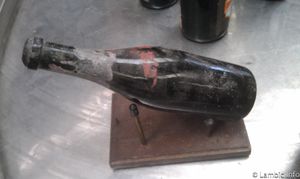Serving Lambic
Serving Lambic

Lambic has tradtionally been served in a number of ways including directly from wooden casks, to bottles, to modern day draught systems. The various methods of serving lambic can often coincide with the equipment and vessels used to serve the beer, and many of the traditions and methods employed to serve lambic have remained relatively unchanged since the 19th century.
Casks
From the large oak barrels that house the lambic at the brewery to the small wooden casks that were used to serve lambic at smaller cafés, the original way to begin serving lambic was from the cask. Before blending and bottling geuze became standard, lambic was generally served straight from the cask or sweetened into a faro or lambic doux (sweet lambic). Today, lambic, faro, and fruited lambic from the cask be found in many cafés in the Pajottenland and beyond. The use of casks for the initial serving point likely led to the use of the traditional lambic pitchers.
Lambic Pitchers and Other Stoneware
Main article: Lambic pitchers and other stoneware
Many lambic drinkers are familiar with the blueish-gray hued clay pitchers that many lambic breweries use to serve their beers. Their history dates back to the 16th century. Many believe that the first historical depiction of this stoneware being used for lambic (more specifically faro) is in Pieter Bruegel's painting The Peasant Wedding (Le Repas de noce, French, De boerenbruiloft, Dutch).[1] Through the years, many lambic brewers and blenders as well as cafés have produced a number of branded and unique pitchers.
Baskets
Because many lambics are generally stored on their side, the use of lambic baskets is common when serving bottles recently pulled from the cellar. Traditional, unfiltered lambic contains sediment. As lambic matures on its side in cellars, this sediment accumulates on the side of the bottle. Getting a clean pour from the bottle without sediment is preferable, and the basket helps prevent this.
Many of the baskets used for serving lambic are originally meant for serving wine. They are traditionally made of wicker and hold the bottle in a slightly upright angle of around 20-23 degrees. The benefit is two-fold. First, these baskets help to keep the bottle at an angle that encourages the sediment to rest in place without being disturbed by being moved to a completely vertical position. Second, the baskets serves as a way to resettle any yeast that is leftover from the bottle not being poured out completely the first time.
Lambic baskets are generally used for 75cl bottles, though 37,5cl and 1.5-liter baskets do exist.
Bottles and Corkscrews

The first mention of lambic being bottled for export occurs in 1844.[2] Lambic bottles are thick walled, reinforced, Champagne style bottles. In fact, some brewers actually used emptied Champagne bottles from France in the early days of bottling.[3][2] The bottles are often green or brown in color and typically ranged from 70cl to 80cl, though the standard today is 75cl. Smaller 37,5cl half-bottles are also common. Some breweries, including Boon and Timmermans have also used smaller 25cl bottles. Before labeling became prevalent, brewers and blenders used a white painted strip across the bottle to indicate geuze, and a red painted stripe to indicate kriek.
The bottles are filled and topped with either a wine- or mushroom-style cork. In the case of the 'mushroom' style cork, a metal cage is also placed over the cork and tightened around the lip of the bottle. In the case of a wine cork, a metal crown cap is applied to prevent the cork from popping out during the secondary fermentation in the bottle.

Additionally, in the case of the flat-corked bottles, several lambic breweries and blenders have a specific type of corkscrew known in French as a tire bouchon de comptoir (counter top-mounted corkscrew). Though there are many versions of this type of cork screw, one of the most prevalent is a corkscrew made by the British company Gaskell and Chambers called The Don. This corkscrew was produced around the turn of the 20th century, and is still used today in places like De Cam Geuzestekerij and the Grote Dorst pub. The base seen supporting this corkscrew is not part of the original design, and was constructed specifically to put the corkscrew at an angle which would open the lambic while resting in a basket. In addition to The Don, there are several other models produced by the same company.
Glassware
There are many different types of glasses used for serving lambics. The most common is a traditional straight-walled tumbler. It is a versatile glass used for all types of lambics. Guinard notes that a large, brandy-type glass is used for drinking kriek while a champagne-style flute is used for drinking framboise.[3] Nearly every style of glassware has been used by breweries and cafés alike to serve lambic, though the most common is still a tumbler.
Pouring a Lambic
Lambic should be poured very slowly, especially in the case of carbonated lambics like geuze and fruited lambic, so as to not disturb the sediment. The lambic should be poured into a tilted glass that eventually moves to the upright position. In the video below, Armand Debelder of 3 Fonteinen demonstrates the pouring technique for a geuze. In the video he can be seen discarding a very small portion of the lambic upon opening due to sediment and pouring the bottle into two glasses in a single motion without stopping.
References
- ↑ Raymond Buren, Gueuze, Faro, et Kriek, 1992
- ↑ 2.0 2.1 Jef Van den Steen, Geuze & Kriek: The Secret of Lambic Beer, 2012
- ↑ 3.0 3.1 Jean-Xavier Guinard, Classic Beer Styles: Lambic, 1990